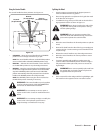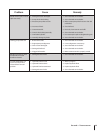
Maintenance & Adjustments
6
15
WARNING! Do not make any adjustments without
stopping the engine, disconnecting the spark plug
wire, grounding it against the engine and relieving
the hydro system pressure. Always wear safety
glasses during operation or while performing any
adjustments or repairs.
Engine
Refer to the Engine Operator’s Manual packed with your log
splitter for all engine maintenance.
Tire Pressure
The max recommended operating pressure is 30 psi. Do
not, under any circumstances, exceed the manufacturer’s
recommended psi. Maintain equal pressure on all tires.
WARNING! Excessive pressure when seating beads
may cause the tire/rim assembly to burst with force
sufficient to cause serious injury. Refer to the
sidewall of the tire for recommended pressure.
Hydraulic Fluid
Check the hydraulic fluid level in the log splitter reservoir tank
before each use. Maintain the fluid level within the range specified
on the dipstick at all times.
Change the hydraulic fluid in the reservoir every 100 hours of
operation. The filter should also be changed with each hydraulic
fluid change. Follow the steps below:
1. Place a suitable oil collection container under the tank.
2. If your engine has a horizontal engine set-up shown in Figure
6-1, refer to Figure 6-1 for changing the hydraulic fluid.
Suction
Hose
Inlet
Filter
Figure 6-1
3. If your engine has a vertical set-up shown in Figure 6-2,
refer to Figure 6-2 for changing the hydraulic fluid.
Suction
Hose
Inlet
Filter
Figure 6-2
4. Disconnect the suction hose from the bottom of the
reservoir tank. See Figure 6-1 for horizontal engines or
Figure 6-2 for vertical engines.
5. Carefully unthread the inlet filter and clean it with
penetrating oil. See Figure 6-3.
Inlet Filter
Figure 6-3
6. Allow the fluid to drain into a suitable container.
NOTE: The reservoir tank has a capacity of 3 gallons and
the entire hydraulic system has a capacity of approximately
4.7 gallons.


















